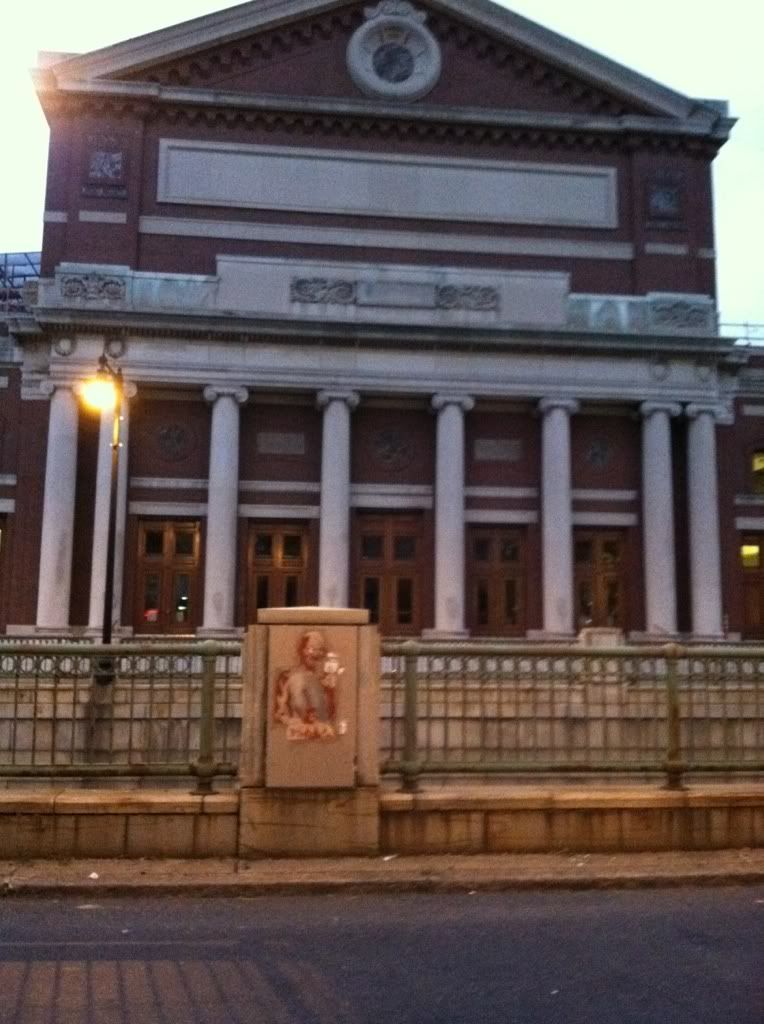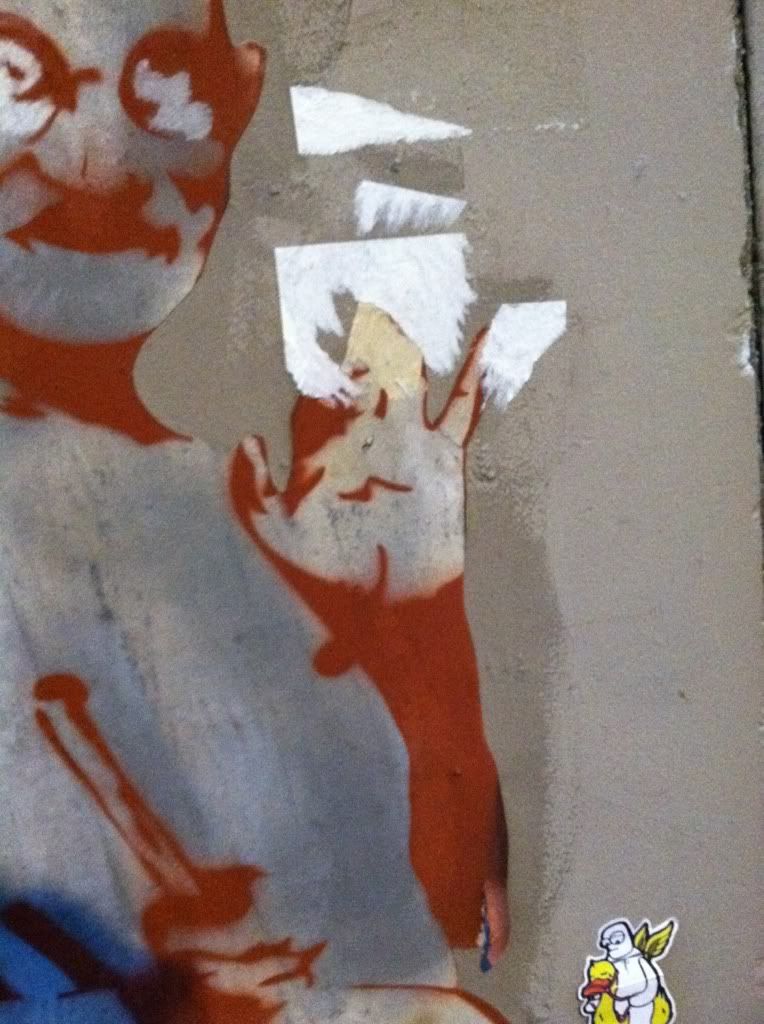A New Cult (Sticker Project), Sam Freedman
Although I don't have an image, I assume many of you saw where I placed my sticker (on the stairwell leading down to our classroom in the dungeons of the library). I put my sticker here because I wanted to play with the themes of public/private as well as the unspoken, psychologically-binding mentalities that encode various cultural groups (i.e. Hipsterism). The image [sticker] only means something to those of us in ANTH2350; the significance for other students, professors, and janitors (who will perhaps be charged with removing the sticker at some future date) is nonexistent save each individual's unique interpretation of the image's content [itself]. Because of our class assignment, the sticker has become imbued with meaning, with a story and correlating details to which only a small percentage of the viewing public has access. The placement of the sticker thus becomes an agent of cultural segmentation, whereby those of us who recognize the story behind the image are assembled, gathered, and 'cult-ified'- we form, in spite of any nascent intentions, a selective, insular body within the overarching cultural matrix.
Guerrilla Gardening @ Occupy
http://permaculture-media-download.blogspot.com/2011/10/guerilla-gardening-occupy-wall-street.html
Illegal Graffiti Picture
http://blogs.wsj.com/photojournal/2011/10/27/photos-of-the-day-oct-27-2/
Hana
sam levy--East Side Gallery
Welcome back consumer culture!
I was wandering down Huntington looking for a suitably incendiary place to put my sticker, when I noticed this sign outside of the dry cleaner near Symphony Market. This sign, ostensibly designed to make students feel more comfortable and ultimately choose this particular business to clean their jungle-juice-stained shirts, takes on a bit of a creepy feel when complemented with this rather violent sticker. It becomes a message not from the well-meaning dry cleaner, who just wants to get that vodka-cranberry stain out of your nice dress at a decent price, but rather from the consumer culture that somehow convinces an astounding number of people to pay $135 for a pair of sneakers because they were named after a basketball celebrity and have been ruthlessly marketed to their demographic. "Welcome back students," it says, "to another year of brand-worshipping consumerism at the cost of the people who made your shoe at less than minimum wage because a minimum wage doesn't exist in their country because the company that designed your glamorous shoe and convinced you that you needed it has lobbied, bribed, and coerced their government into deregulating industry so they can work in free trade zones and take all their profits out of the country without paying taxes!!!!"
^I tried to make that as angry as the sticker.
- Rebecca Willett
Sticker Assignment
I selected a sticker that shows a figure stuck inside of the international "no" sign. He is sweating and reaching out towards the viewer. I interpreted this as his attempt to escape from captivity inside some set of rules that prevent him from doing what he wants. In short, this figure seems like a rebel rejecting societal rule.
I placed this sticker besides a few "no" signs in the city before I found this spot. This is the green line Park Street stop on the T, an extremely crowded place, especially during rush hour when I placed the sticker there. I thought it would be fun to place this "no" sticker besides another "no" sign. It works especially well here because the signs are about the same size. The hope is that people will do a double take as they pass by yet another sign that tells them what not to do.
I am not encouraging people to smoke in the T-station, but perhaps the juxtaposition of the stickers have people question the amount of "no's" we see every day, and who is creating these rules that we are forced to follow. People spend a lot of time waiting for the T and likely have a lot of time to stare and think about the sticker while waiting. Perhaps it will change the "place" where one waits for the T to a "space" where one can question rules and conformity.
Hana Nobel
Julie Giles
samantha levy sticker assignment
Sticker Posting
- Preston
Berlin Street Art
http://www.smashingmagazine.com/2011/07/13/the-heritage-of-berlin-street-art-and-graffiti-scene/]
I came across this interesting article on street art in Berlin that gives brief analysis on a few well know street artists in the area but also briefly mentions the history of Berlin's street art in connection with the Berlin wall.
One of the artists, Alias, I thought demonstrates well what we discussed about street art as a subculture based on it's giving a voice to the voiceless as well as on the need to both feel treated unfairly by and stay anonymous to the dominant however this street artist does not use graffiti as his medium and instead employs stencils in the style on banksy and produces a constant stream of art for the purpose of keeping his art, although not himself, in the public eye.
"The picture of a hooded teenager with a blank face communicates a need to give outsiders a voice. The irony is that the one person humane enough to give them that voice, a street artist, has to remain anonymous. That, Alias suggests, is his reward for daring to question society."
To counter this conception of street art as a method of attacking the dominant culture there is an artist referred to XOOOX who personally claims that his works of art have nothing to do with criticism of capitalism, as they often are interpreted to, but are simply at outpouring of his love for fashion. His stencils are created from his fashion magazines and he too produces a constant stream of art to remain in the public eye.
Overall, XOOOOX’s images show an artist with a genuine appreciation of conventional beauty. In a scene that likes to subvert conventions, this must make XOOOOX the most unconventional artist working on Berlin’s streets today.
In comparing these two street artists from the same city who both produce art on a massive scale(with a new work practically every day) what category do you think we would have placed them in in our discussion?
-Katherine
Street Art Assignment
The view from the top of the garage is remarkably scenic. When you're on the roof of any building in Boston (or any city for that matter), there is this sensation of omnipotence. It's as though because you can see the whole city, the whole city can somehow see you. The sticker and lamp post seems so large up against the city backdrop, which visually replicates that invigorating sensation from looking out at the city from the rooftop of a building.
I now see why many street artists choose to write on high up places (like in Exit Through the Gift Shop when Shepard Fairey is shown placing numerous prints on roofs of buildings and on highway overpasses). Not only does this accomplish the task of giving a voice to the voiceless, it places the message literally above where the craziness of everyday urban life occurs. It's as though the message will somehow trickle down to the streets, which to me is a very cool concept.
So my placement of the sticker on this lamp post accomplishes my attempt to give meaning to an otherwise meaningless lamppost on a parking garage. It now invites whoever sees it to think about how they see themselves compares to the city, and it tempts them to think bigger and not be overwhelmed by the size of the city. It allows for me to feel important as the writer for getting attention, and it also allows people to indulge in that momentary rush of looking down at a city and feeling as though you are floating above it. It's also just a nice view.
I decided to place my sticker on on of the bridges behind the school that go over the train tracks to cabot center and some of the further dorms. Since freshman year I've been going across these bridges to get to dance classes, the gym and friends dorms and I have always found them to be a place totally alien to the traditional idea of a college campus. I don't know if the fencing and guard towers are supposed to make you feel protected or constantly watched but in short the place feels like you've temporarily taken a wrong turn and ended up in prison. I was hoping that the addition of some sort of street art would make the detour less menacing but of course with the constant and very blatant patrolling of cops I had to make it very obvious that I was simply taping the sticker up temporarily and take it down immediately after my photos.
-Katherine
Daniel Hewes- Those who benefit
I chose a sticker that I think had a lot of meaning behind it. It was of a sneaker with the Nike swoosh piercing through the character inside the shoe. I think it represents our society's over consumption of brands and labels, and our downfall because of it. But I also think that the meaning is 2 fold. One, that theres a level of desire for the brands for those who are economically not well off. The less they have, the more they want items that represent more affluent types. The other side, which I chose to capture in my image are those who reap the benefits of the consumption of all these goods. Theres massive wealth and money for those who gain from society's consumer culture.
It was hard to capture wealth is a single shot so I decided to venture over to Beacon Hill's Louisburg Square, where some of the wealthiest residents live. The square is lined with townhouses and mansions and is quite beautiful. I placed the sticker on the street sign, as a contrast between the exclusive address and those who benefit and the downfall of our culture caused by mass consumption.
Even Gandhi Would Smile
What are YOU up to?
taken at 126 Hemening Way
Back The Way You Came
Body to Person, Place to Space






























